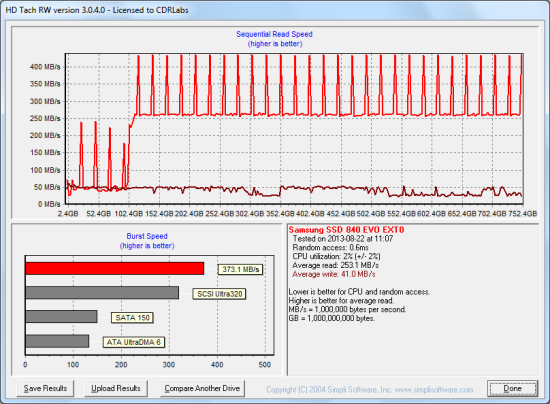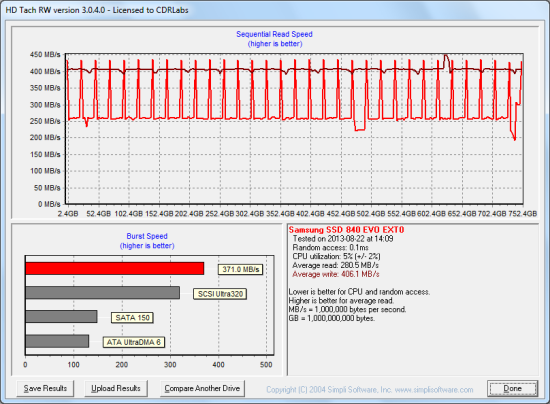TRIM Performance:
While SSDs offer many benefits, there are some downsides to using flash memory. One of the biggest issues people run into is performance degradation. Over time, an SSD will run out of fresh blocks and will have to write over data the file system has marked as deleted. This procedure is very complicated and can slow an SSD's write speeds considerably.
To fix this problem, most manufacturers have added TRIM support to their SSDs. The TRIM command allows an operating system, such as Windows 7, to tell an SSD which data blocks are no longer in use. Using this information, the drive pro-actively erases these blocks and adds them to the free block pool.

To test the SSD 840 EVO's TRIM function, I first put the drive in a "dirty" state. I used Iometer to fill the entire drive and then ran a random write test for 30 minutes. Looking at the screenshot below, you can see that the SSD 840 EVO's average read and write speeds dropped to 253.1 MB/s and 41.0 MB/s, respectively.

Samsung SSD 840 EVO 750GB - Dirty
To see how well the SSD 840 EVO could recover, I let the computer sit for a few hours and then reran the test. The drive's average write speed climbed up to 406.1 MB/s. However, its read speed still lagged a bit behind, averaging out at 280.5 MB/s.

Samsung SSD 840 EVO 750GB - After Trim
Lastly, I used Samsung's SSD Magician software to perform a secure erase of the SSD 840 EVO. With the drive wiped clean, it had average read and write speeds of 412.9 MB/s and 401.6 MB/s, respectively.

Samsung SSD 840 EVO 750GB - Secure Erase
Final Thoughts:
Samsung has knocked another one out of the park with its new 840 EVO Series SSD. Designed and built entirely in-house, this ultra-slim, high-capacity drive combines Samsung's triple-core MEX controller with their second generation 3-bit MLC NAND flash. Add in a massive DRAM cache and Samsung's new TurboWrite technology and you have a drive capable of some pretty impressive performance. In our sequential read and write tests, the 750GB version of the SSD 840 EVO was able to read at speeds as high as 560 MB/s and write at speeds in excess of 490 MB/s. The drive also did very well in our random write tests, producing more than 85,000 IOPS at low queue depths. While a big improvement over the SSD 840, these numbers aren't as high as what we saw with the SSD 840 Pro. However, with RAPID mode enabled, the performance can be boosted beyond what a single, SATA SSD is normally capable of.
The best thing about the SSD 840 EVO is the price. With the performance and features the drive offers, Samsung could have set the price somewhere in between the SSD 840 and SSD 840 Pro and no one would have batted an eye. Instead, they've priced it in line with the SSD 840, making it one of the best bangs for your buck, especially if you're looking for a high-capacity drive.
The SSD 840 EVO is available now in 120GB, 250GB, 500GB, 750GB and 1TB capacities. Prices on Amazon.com currently range from $109 up to $650, with the 750GB version reviewed here going for about $529.

Highs:
- Available in 120GB, 250GB, 500GB, 750GB and 1TB capacities
- Features RAPID mode and TurboWrite technology
- Excellent sequential read and write speeds
- Very good random read and write performance
- Performs equally well with compressible and incompressible data
- Good looking, ultra-slim design
- SATA 6Gb/s interface
- Large SDRAM cache
- Supports TRIM, garbage collection and wear leveling
- AES 256-bit full disk encryption
- Includes SSD Magician software and Data Migration Tool
- 3 year warranty
Lows:
- Samsung's 3-bit MLC NAND is not as durable as 2-bit MLC NAND

